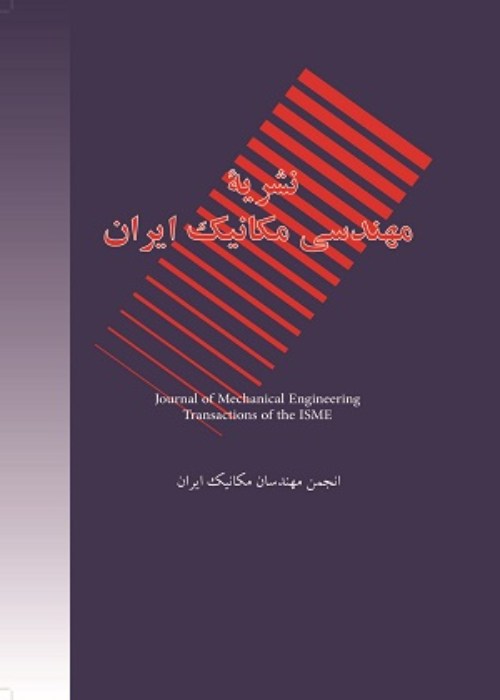investigation of the longitudinal effects of second step from base on the kogar vessel perfomance
Author(s):
Article Type:
Research/Original Article (دارای رتبه معتبر)
Abstract:
The basis of planing vessels motion is the use of low drag force to lift force. One of the main goals in the design of planing vessels is to reduce the hydrodynamic resistance and achieve higher speeds. For this purpose, using a hydrodynamic correct analysis is an important step.
In this study, a three-dimensional model of computational fluid dynamics is presented using a finite volume discretization on a structured network to study the flow pattern under the body of COUGAR model in different modes. Therefore, for the numerical simulation of COUGAR model, the commercial software of the ANSYS-CFX has been used. The VOF method was used to study the distribution of two fluid phases and free surface modeling. Thus, the fundamental equations governing the flow of fluid around the cougar model are solved and the distribution of velocity and pressure in the computational domain will be obtained.
In these simulations, the model is considered constant and the fluid moves. Simulations at trim angles of 1,2 and 3 degree and drafts of 10.7, 11,77 and 12/84 cm (equivalent to weights 9.5, 10.5 and 11.5 tons in the main vessel) and three speeds of 8.52, 11.5 and 14.95 meters per second (35, 50 and 65 knots for the main vessel) is done. The Studied geometry is two-steps cougar model. The length of the second step is three different distances from the aft and values 34, 38.5, and 43 cm. Thus, the exact results of the vessel hydrodynamic resistance, the pressure distribution on the body, the waveform and the lifting force will be obtained for all three bodies. For verification, the independence of the network as well as the validation of the results with the laboratory model is carried out. Comparison of the simulation results with the experimental results of the 38.5 cm model, which was tested in the Persian Gulf National Laboratory, is in good agreement. The maximum error rate for drag of two-step vessel at a speed of 11.5 m / s is 12.4% and satisfies the experimental results. Studies show that in a loading and constant velocity, the vessel drag increases with the increase of the second step length from of aft vessel.
In this study, a three-dimensional model of computational fluid dynamics is presented using a finite volume discretization on a structured network to study the flow pattern under the body of COUGAR model in different modes. Therefore, for the numerical simulation of COUGAR model, the commercial software of the ANSYS-CFX has been used. The VOF method was used to study the distribution of two fluid phases and free surface modeling. Thus, the fundamental equations governing the flow of fluid around the cougar model are solved and the distribution of velocity and pressure in the computational domain will be obtained.
In these simulations, the model is considered constant and the fluid moves. Simulations at trim angles of 1,2 and 3 degree and drafts of 10.7, 11,77 and 12/84 cm (equivalent to weights 9.5, 10.5 and 11.5 tons in the main vessel) and three speeds of 8.52, 11.5 and 14.95 meters per second (35, 50 and 65 knots for the main vessel) is done. The Studied geometry is two-steps cougar model. The length of the second step is three different distances from the aft and values 34, 38.5, and 43 cm. Thus, the exact results of the vessel hydrodynamic resistance, the pressure distribution on the body, the waveform and the lifting force will be obtained for all three bodies. For verification, the independence of the network as well as the validation of the results with the laboratory model is carried out. Comparison of the simulation results with the experimental results of the 38.5 cm model, which was tested in the Persian Gulf National Laboratory, is in good agreement. The maximum error rate for drag of two-step vessel at a speed of 11.5 m / s is 12.4% and satisfies the experimental results. Studies show that in a loading and constant velocity, the vessel drag increases with the increase of the second step length from of aft vessel.
Keywords:
Language:
Persian
Published:
Iranian Journal of Mechanical Engineering, Volume:20 Issue: 2, 2018
Pages:
92 to 114
magiran.com/p1897799
دانلود و مطالعه متن این مقاله با یکی از روشهای زیر امکان پذیر است:
اشتراک شخصی
با عضویت و پرداخت آنلاین حق اشتراک یکساله به مبلغ 1,390,000ريال میتوانید 70 عنوان مطلب دانلود کنید!
اشتراک سازمانی
به کتابخانه دانشگاه یا محل کار خود پیشنهاد کنید تا اشتراک سازمانی این پایگاه را برای دسترسی نامحدود همه کاربران به متن مطالب تهیه نمایند!
توجه!
- حق عضویت دریافتی صرف حمایت از نشریات عضو و نگهداری، تکمیل و توسعه مگیران میشود.
- پرداخت حق اشتراک و دانلود مقالات اجازه بازنشر آن در سایر رسانههای چاپی و دیجیتال را به کاربر نمیدهد.
In order to view content subscription is required
Personal subscription
Subscribe magiran.com for 70 € euros via PayPal and download 70 articles during a year.
Organization subscription
Please contact us to subscribe your university or library for unlimited access!


